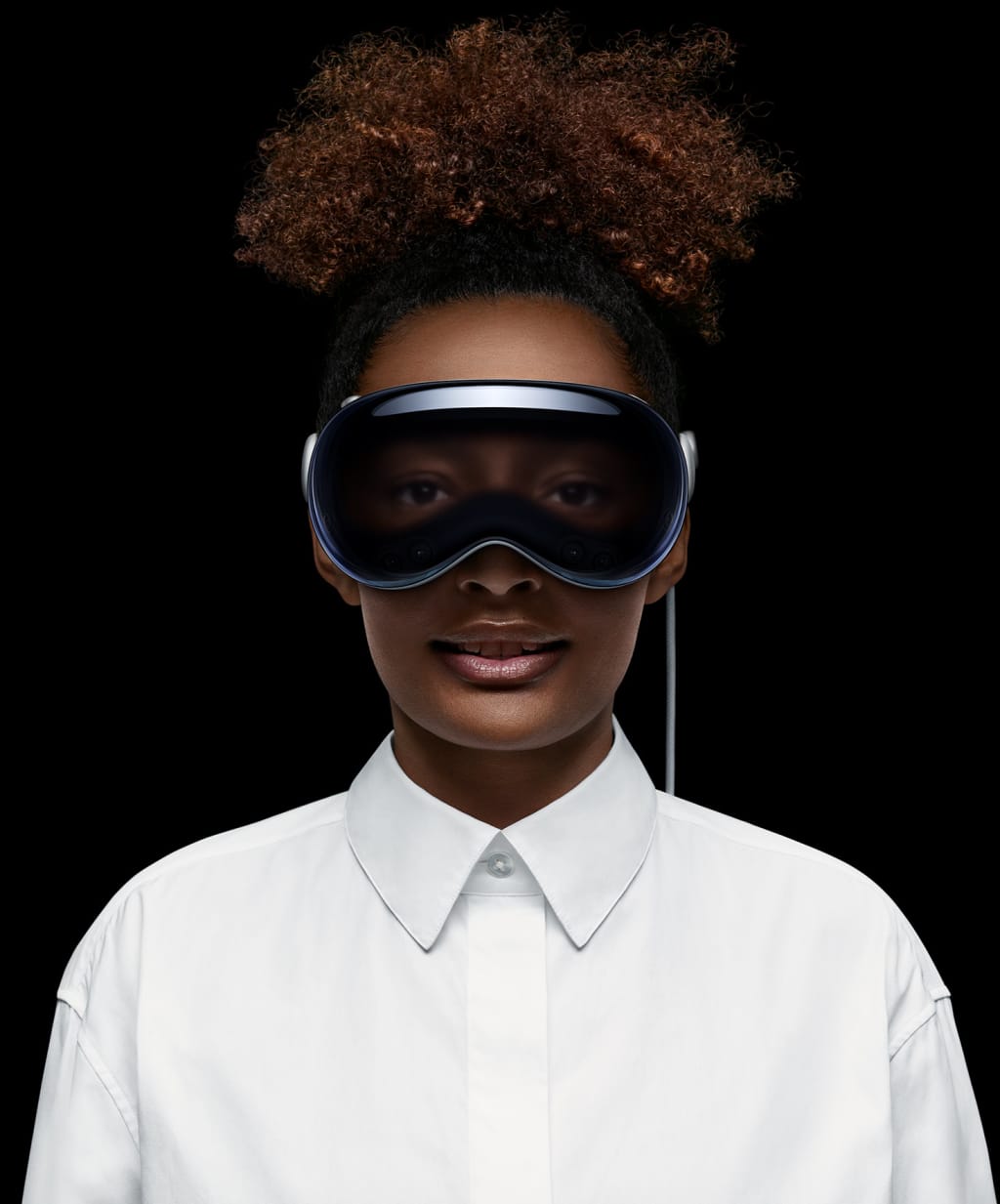
Introduction
Apple's recently unveiled Vision Pro mixed reality headset has taken the internet by storm, sparking both admiration and skepticism. While some consider it to be an unconventional and eccentric device, early users have expressed overwhelming enthusiasm about its intuitive interface, unparalleled image quality, and magical experience. In this article, we will delve into the unique features and technical achievements of the Vision Pro, exploring its potential to revolutionize the technology landscape.
Blurring the Boundaries of Augmented and Virtual Reality
The Vision Pro is not just another virtual reality (VR) or augmented reality (AR) headset; it seamlessly transitions between both states. Users can interact with the device using their fingers, eyes, and voice for basic tasks, a keyboard and mouse for productivity, or a controller for gaming. Apple has strived to overcome the motion sickness issue prevalent in many XR systems today, ensuring a smooth and powerful experience for its users.
A Leap in Technical Innovation
To create the Vision Pro, Apple embarked on an extensive hiring spree, assembling a team of experts in VR and AR technology. Additionally, the company acquired several VR and AR companies, leveraging their technical knowledge and expertise. With over 5,000 patents, Apple has pushed the boundaries of design and engineering to bring this product to fruition.
A Historical Perspective: Apple's Tradition of Perfecting Existing Technology
Apple has a track record of perfecting existing technology rather than inventing it. Just as they revolutionized computer interaction with the introduction of the mouse and the smartphone industry with the iPhone, the Vision Pro aims to redefine how we work with computers. By combining elements of VR and AR with precise hand and eye tracking, Apple has created an interface that feels almost telepathic, streamlining navigation and interaction in a three-dimensional environment.
The Vision Pro: A 3D iPhone
Apple's integration of iPad and iOS apps with the Vision Pro further emphasizes their goal of creating a cohesive ecosystem across all their devices. The headset's interface elements float in 3D space, offering expandability and flexibility. Users can even project their MacBook screen into the air and continue their work in a 3D environment. Apple aims to create a unified experience where apps seamlessly adapt to different devices.
Unprecedented Clarity and Immersion
With 23 million pixels crammed into two screens, the Vision Pro boasts exceptional image quality comparable to a micro LED 4K TV for each eye. Users have marveled at the sharpness and crispness of text, making web browsing and productivity tasks a joy. With 5,000 nits of peak brightness, the Vision Pro surpasses its competitors, offering superior contrast, brighter colors, and better highlights.
Eye Tracking and Realistic Immersion
One of the standout features of the Vision Pro is its precise eye tracking capability. Users can navigate the interface effortlessly by simply moving their eyes, experiencing a telepathic-like interaction. Apple's custom R1 chip, responsible for driving imagery with a latency of 12 milliseconds or less, reduces motion sickness and enhances realism. The headset's internal cameras, combined with AI algorithms, enable predictions of user actions, further enhancing the overall experience.
Drawbacks and Pricing
The Vision Pro does come with a few drawbacks. Its weight makes prolonged use uncomfortable, and the two-hour battery life limits extended sessions. However, considering the intensive computational requirements and cutting-edge technologies involved, the $3,500 price tag becomes more understandable. Apple's investment in research and development, combined with the cost of custom components, contribute to the higher price point.
The Future of Computing and Potential Challenges
While the Vision Pro may not achieve the same level of popularity as the iPhone, it has the potential to popularize a new era of computing. While the Apple Vision Pro mixed reality headset has generated both excitement and skepticism, there's no denying that it brings a new dimension to computing. As someone who has dabbled with similar devices, I can attest to the transformative experience it offers.
Apple's foray into the mixed reality space has sparked a heated debate on the internet. Some critics dismiss the device as goofy and impractical, while early users have been effusive in their praise. The headset's intuitive interface, rapid responsiveness, and superior image quality have left a lasting impression on those who have had the opportunity to try it.
One of the standout features of the Vision Pro is its ability to seamlessly transition between augmented reality (AR) and virtual reality (VR). Users can employ their fingers, eyes, and voice for basic tasks, or opt for a keyboard, mouse, or controller depending on the purpose. Apple has made significant strides in overcoming the challenge of motion sickness, a common issue with XR systems, making the overall experience more immersive and comfortable.
It's important to note that while virtual reality and augmented reality are not new concepts, Apple's device sets itself apart by excelling in both realms. Gaming-focused VR headsets like the MetaQuest and PSVR offer limited AR capabilities, whereas AR devices like the Vario XR3 or Microsoft's HoloLens 2 prioritize productivity and lack VR functionalities. Apple's ability to deliver high-quality experiences in both AR and VR is a significant engineering feat, albeit an expensive one with a price tag of $3,500.
Behind the scenes, Apple has invested heavily in acquiring VR and AR expertise, recruiting industry experts and acquiring companies with specialized knowledge. With thousands of patents under their belt, Apple has leveraged this technical know-how to create a truly groundbreaking product. The Vision Pro can be seen as a paradigm shift in computing, much like the iPhone was to the desktop computer.
Apple's approach has always been about refining existing technologies rather than inventing them. They have a knack for perfecting user interfaces and creating seamless experiences. Just as they revolutionized computing with the introduction of the mouse and touchscreen, Apple aims to do the same with XR headsets.
In many ways, the Vision Pro can be considered a 3D iPhone. With support for thousands of iPad and iOS apps, it offers an ecosystem where applications can work across multiple devices. The interface elements float in 3D space, allowing users to expand, move, and interact with them effortlessly. The responsiveness of the device, coupled with the ability to transport users to virtual environments of their choosing, opens up new possibilities for productivity and entertainment.
The eye-tracking technology in the Vision Pro is particularly impressive. Users can navigate the interface by simply moving their eyes, with the device accurately highlighting and selecting the desired elements. This level of precision is made possible by AI algorithms and a sophisticated system of cameras and sensors embedded within the headset.
The display quality of the Vision Pro is unparalleled. Apple has managed to fit 23 million pixels into two screens, providing an incredibly sharp and vivid visual experience. With a peak brightness of 5,000 nits, the headset offers superior contrast, brighter colors, and better highlights than its competitors. The R1 chip drives the imagery with a latency of just 12 milliseconds, effectively reducing motion sickness and ensuring a smooth experience.
Despite its technical achievements, the Vision Pro does have some limitations. Its weight makes it uncomfortable for extended periods of use, and the relatively short battery life of two hours can be a hindrance. However, these trade-offs are likely a result of the intensive processing power required by the device. Additionally, the high price point of $3,500 reflects the extensive research and development costs, as well as the premium components used.
While the Vision Pro may not reach the same level of mainstream adoption as the iPhone or other Apple products initially, it undoubtedly sets the stage for future advancements in mixed reality technology. As with any new product category, there will be early adopters and enthusiasts who are eager to explore its capabilities and push its boundaries.
As Apple continues to refine and iterate on the Vision Pro, we can expect to see improvements in areas such as comfort, battery life, and affordability. Apple's track record of iterative product development suggests that subsequent generations of the headset will address these limitations and make mixed reality more accessible to a wider audience.
Furthermore, the introduction of the Vision Pro is likely to spur innovation and competition in the mixed reality market. Other tech giants and startups will be inspired to develop their own headsets, pushing the boundaries of what is possible in terms of hardware, software, and user experience. This competition will ultimately benefit consumers, as it drives advancements and lowers costs.
In conclusion, the Apple Vision Pro mixed reality headset represents a significant milestone in the evolution of computing and human-computer interaction. While it may face initial skepticism and challenges, its combination of augmented and virtual reality capabilities, coupled with Apple's emphasis on seamless user experiences, makes it a promising device with vast potential. As the technology continues to evolve and improve, we can expect mixed reality headsets like the Vision Pro to shape the future of how we work, play, and interact with digital content.





Comments
There are no comments for this story
Be the first to respond and start the conversation.